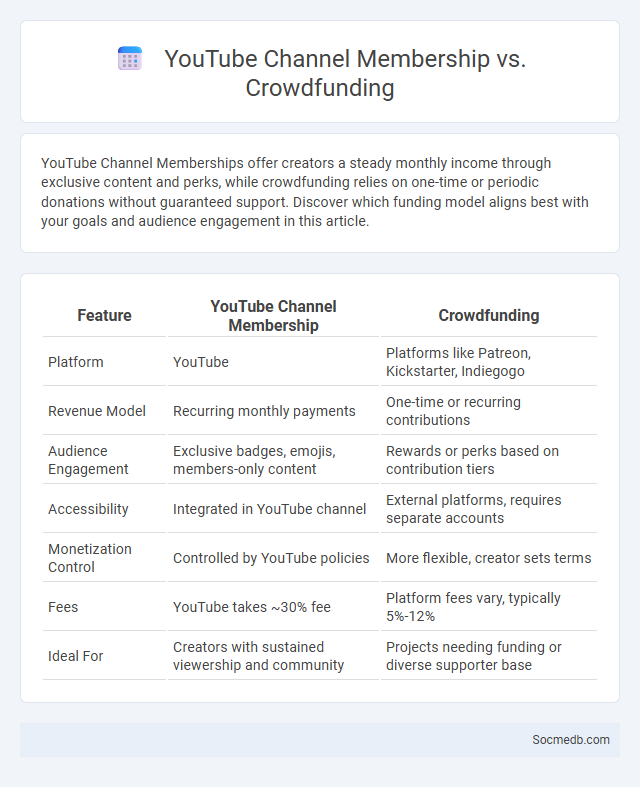
Photo illustration: YouTube Channel Membership vs Crowdfunding
YouTube Channel Memberships offer creators a steady monthly income through exclusive content and perks, while crowdfunding relies on one-time or periodic donations without guaranteed support. Discover which funding model aligns best with your goals and audience engagement in this article.
Table of Comparison
| Feature | YouTube Channel Membership | Crowdfunding |
|---|---|---|
| Platform | YouTube | Platforms like Patreon, Kickstarter, Indiegogo |
| Revenue Model | Recurring monthly payments | One-time or recurring contributions |
| Audience Engagement | Exclusive badges, emojis, members-only content | Rewards or perks based on contribution tiers |
| Accessibility | Integrated in YouTube channel | External platforms, requires separate accounts |
| Monetization Control | Controlled by YouTube policies | More flexible, creator sets terms |
| Fees | YouTube takes ~30% fee | Platform fees vary, typically 5%-12% |
| Ideal For | Creators with sustained viewership and community | Projects needing funding or diverse supporter base |
Introduction to YouTube Monetization Options
YouTube monetization options include AdSense revenue, channel memberships, Super Chat, and merchandise shelf integration, allowing creators to earn income through multiple streams. AdSense revenue depends on video views and ad engagement, while channel memberships let subscribers access exclusive perks for a monthly fee. Super Chat enables viewers to pay for highlighted messages during live streams, and the merchandise shelf facilitates direct sales of branded products, optimizing creator income opportunities.
What is YouTube Channel Membership?
YouTube Channel Membership is a subscription feature that allows viewers to support their favorite creators by paying a monthly fee in exchange for exclusive perks such as badges, emojis, and members-only content. Your membership offers direct access to enhanced interaction with the channel through live chats and special videos not available to the general public. This feature helps creators generate steady revenue while providing fans unique experiences and a closer community connection.
Understanding Crowdfunding for Creators
Social media platforms play a crucial role in crowdfunding for creators by enabling direct engagement with target audiences and facilitating the sharing of project updates and rewards. Creators leverage social media channels like Instagram, Twitter, and TikTok to build trust, showcase their work, and mobilize financial support through campaigns on platforms such as Kickstarter and Indiegogo. Effective social media strategies increase visibility, enhance emotional connection with backers, and drive successful fundraising outcomes for creative projects.
Channel Membership on Other Platforms Explained
Channel membership on platforms like YouTube, Twitch, and Facebook allows creators to monetize content through subscriber-based models, offering exclusive perks such as badges, emojis, and member-only content. These memberships boost audience engagement and provide a steady revenue stream beyond traditional ad-based earnings. Understanding platform-specific features and audience preferences is crucial for maximizing the benefits of channel memberships across diverse social media channels.
Key Features: YouTube Membership vs Crowdfunding
YouTube Membership offers exclusive badges, emojis, and members-only content directly integrated into your channel, allowing your audience to support you with recurring payments. Crowdfunding platforms like Patreon or Kickstarter provide more flexible funding options, including one-time pledges and various reward tiers, but lack the seamless integration with video content that YouTube Membership provides. Your choice depends on whether you prefer direct community engagement within YouTube's ecosystem or broader funding possibilities from external platforms.
Revenue Streams: Comparing Earnings Potential
Social media platforms generate revenue primarily through advertising, with giants like Facebook and Instagram leading in ad sales driven by extensive user data and targeting capabilities. Subscription models, such as Twitter Blue or LinkedIn Premium, contribute additional income by offering exclusive features and enhanced user experiences. E-commerce integrations and virtual gifting also represent growing streams, leveraging platform engagement to boost direct consumer spending.
Audience Engagement: Building Loyal Communities
Audience engagement on social media is driven by authentic interactions and consistent content tailored to the target demographic's preferences and behaviors. Leveraging user-generated content, personalized responses, and interactive features such as polls and live videos fosters a sense of community and trust. Analyzing engagement metrics like comments, shares, and active participation helps refine strategies to build loyal and highly engaged online communities.
Platform Fees and Payment Structures
Social media platforms often implement platform fees ranging from 5% to 30% on creators' earnings, directly impacting revenue from content monetization, subscriptions, and digital goods sales. Payment structures vary widely, with some platforms providing instant payouts while others follow a monthly or bi-weekly schedule, affecting creators' cash flow management. Understanding these fees and payment timelines is crucial for maximizing profitability and planning sustainable income streams in the digital economy.
Pros and Cons: Choosing the Best Strategy
Social media offers businesses powerful tools for brand awareness, customer engagement, and targeted advertising, driving higher conversion rates and real-time feedback. However, its fast-paced environment demands continuous content creation and exposes Your brand to potential negative publicity and privacy concerns. Balancing these benefits and drawbacks is critical to crafting a strategy that maximizes ROI while protecting Your online reputation.
Conclusion: Selecting the Right Monetization Method
Choosing the right monetization method for your social media platform depends on your audience engagement, content type, and growth strategy. You should evaluate options like sponsored posts, affiliate marketing, subscription models, and ad revenue based on how they align with your brand and user expectations. Prioritizing methods that enhance user experience while maximizing revenue ensures sustainable social media success.
 socmedb.com
socmedb.com